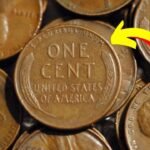The Lincoln Wheat Penny has long been a cornerstone of American coin collecting. First introduced in 1909 to commemorate the 100th birthday of President Abraham Lincoln, this coin not only marked a major shift in U.S. coinage design but also sparked a cultural fascination that continues to this day. It was the first U.S. coin to feature a real historical figure rather than a symbolic representation of Liberty, and since then, the Lincoln Wheat Penny has grown into one of the most iconic—and at times, highly valuable—coins ever minted.
But what truly captures collectors’ imaginations is a particular penny from the series: the legendary 1943 bronze Lincoln Wheat Penny. One specimen of this coin has reportedly been valued at an astonishing $80 million. The idea that such a rare and immensely valuable coin might still be floating around in circulation is both thrilling and surprisingly plausible. Some of the most jaw-dropping coin discoveries in history came from everyday change, forgotten collections, or bank coin rolls.
Let’s dive deep into what makes this coin so unique, why it’s so valuable, and how you might be able to identify one of these ultra-rare Lincoln Wheat Pennies for yourself.
What Makes the 1943 Lincoln Wheat Penny So Valuable?
During World War II, the U.S. Mint made a critical change to the composition of the Lincoln Wheat Penny. Copper was in high demand for the war effort, so the Mint decided to conserve this metal by switching the penny’s composition from its traditional bronze (a copper-based alloy) to zinc-coated steel. This change was meant to be universal in 1943—but, as with many things in manufacturing, mistakes were made.
Some bronze planchets from 1942 were accidentally left in the coin presses when the new steel planchets were introduced. As a result, a very small number of 1943 Lincoln Wheat Pennies were struck using bronze. To date, only an estimated 10 to 15 of these coins have been verified to exist, making them one of the rarest errors in American coinage history.
One of these bronze pennies, discovered in pristine condition, was appraised at an eye-watering $80 million. That makes it not just a valuable coin—it may be the most expensive penny ever known.
Could One Still Be in Circulation
It sounds far-fetched, but the possibility is real. Rare coins have a strange way of staying hidden for decades. Sometimes they’re passed down unknowingly through generations, lost in drawers, tucked away in piggy banks, or rolled up with other change and brought to the bank.
Just imagine finding a 1943 bronze Lincoln Wheat Penny in your change while buying a coffee or going through your grandfather’s old coin collection. That moment of discovery could change your life.
History has proven that such finds are possible. In fact, some of the most famous discoveries of rare Lincoln Wheat Pennies happened entirely by chance.
Real-Life Discoveries: When Ordinary People Found Extraordinary Pennie
| Year Found | Where Found | Estimated Value | Current Status |
|---|---|---|---|
| 1958 | Teen’s pocket change | $40,000 (in 1958 dollars) | Sold to collector |
| 2006 | Inherited coin collection | Over $1 million | Auctioned |
| 2010 | Bank coin roll search | $200,000+ | Privately held |
These cases underscore how sometimes, all it takes is a careful eye and a bit of luck to stumble upon a coin that’s worth far more than face value. A single Lincoln Wheat Penny might just hold the key to an incredible windfall.
What to Look for in a Rare Lincoln Wheat Penny
Finding a valuable coin starts with knowing what to look for. While the 1943 bronze version is the holy grail, there are other highly collectible Lincoln Wheat Pennies that can also be worth hundreds or even thousands of dollars.
1. Check the Year and Composition
If you have a 1943 Lincoln Wheat Penny, test it with a magnet. Steel pennies will stick, but a true 1943 bronze penny will not. The bronze version has a rich copper tone, while the steel version appears gray or silver.
2. Examine the Mint Mark
Coins minted in San Francisco (marked with an “S”) or Denver (marked with a “D”) are generally rarer than those minted in Philadelphia, which have no mint mark.
Some of the most valuable Lincoln Wheat Pennies include:
- 1909-S VDB – The first-year coin with designer Victor D. Brenner’s initials
- 1914-D – Scarce due to limited mintage
- 1922 No D – An error where the Denver mint mark was omitted
- 1955 Double Die – Features a dramatic doubling of the date and lettering
3. Check for Errors
Error coins like double dies, off-center strikes, or wrong planchet compositions can dramatically increase value. These issues often occur during the minting process and can be subtle, so a magnifying glass and a good coin reference guide are essential.
4. Condition is Everything
Coin value often skyrockets when the coin is in excellent condition. Coins graded MS-65 or higher (Mint State) can command huge premiums. Even a common Lincoln Wheat Penny can be worth hundreds if it’s perfectly preserved.
What Should You Do If You Find One?
Let’s say you think you’ve found a rare Lincoln Wheat Penny. What next?
1. Do Not Clean the Coin
Cleaning a coin—even gently—can destroy its value. Collectors and grading services prefer coins in their original, untouched state.
2. Have It Professionally Graded
Send your coin to a reputable grading service like the Professional Coin Grading Service (PCGS) or Numismatic Guaranty Company (NGC). They can verify the authenticity and provide an official grade that determines its market value.
3. Store It Properly
Use a coin capsule or acid-free holder to protect it from environmental damage. Humidity, light, and air exposure can degrade the coin over time.
4. Consider Selling at Auction
If your coin is authentic and valuable, you may want to sell it at a high-end coin auction. Some rare Lincoln Wheat Pennies have sparked intense bidding wars and sold for millions.
Why the Lincoln Wheat Penny Still Captivates Collectors
The story of the Lincoln Wheat Penny is one of American innovation, historical legacy, and the thrill of discovery. It’s not just about the money—though that certainly helps. It’s about holding a piece of history in your hand. These pennies passed through the Great Depression, two World Wars, and the pockets of countless Americans.
What makes the Lincoln Wheat Penny particularly appealing is its accessibility. Unlike gold coins or high-end collectibles that require deep pockets, Lincoln Wheat Pennies can still be found in old coin jars, estate sales, flea markets, and even in daily pocket change.
Even if you don’t uncover the fabled $80 million penny, you might still find one worth hundreds or thousands of dollars. Each one tells a story, and each discovery connects you to a broader community of collectors and historians.
Final Thoughts
The idea that an ordinary-looking Lincoln Wheat Penny could be worth $80 million is both astonishing and inspiring. While the odds are slim, the possibility is real—and it keeps thousands of collectors searching. Whether you’re a beginner learning the ropes or a seasoned numismatist with years of experience, every coin you inspect could be the one.
The enduring fascination with the Lincoln Wheat Penny isn’t just about its value—it’s about the story, the history, and the thrill of the hunt. So the next time you go through your spare change or find an old jar of coins in the attic, take a moment to look closely. That dull, copper coin might just be the find of a lifetime.
FAQs
Q: What is a Lincoln Wheat Penny?
A: The Lincoln Wheat Penny is a U.S. one-cent coin minted from 1909 to 1958, featuring wheat stalks on the reverse. It was the first coin to feature a real person—President Abraham Lincoln.
Q: How do I know if my Lincoln Wheat Penny is valuable?
A: Check the date, mint mark, material, and condition. Rare dates like 1909-S VDB, 1914-D, or 1943 bronze are extremely valuable.
Q: What makes the 1943 bronze Lincoln Wheat Penny so rare?
A: It was struck on the wrong metal during wartime. Only 10–15 are known to exist, making it one of the rarest coins in U.S. history.
Q: How much is a regular Lincoln Wheat Penny worth?
A: Most are worth just a few cents, but key dates or high-grade coins can fetch anywhere from $10 to over $1,000.
Some Important Link
| Telegram Group | Click Here |
| WhatsApp Group | Click Here |
| Home Page | Click Here |










